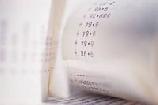
 |
|
| Financial Terms | |
| Basic balance |
|
Information about financial, finance, business, accounting, payroll, inventory, investment, money, inventory control, stock trading, financial advisor, tax advisor, credit.
Main Page: credit, tax advisor, money, business, financial advisor, inventory, payroll, inventory control, |
Definition of Basic balance
Basic balanceIn a balance of payments, the basic balance is the net balance of the combination of the current
Related Terms:Balance of paymentsA statistical compilation formulated by a sovereign nation of all economic transactions Balance of tradeNet flow of goods (exports minus imports) between countries. Balance sheetAlso called the statement of financial condition, it is a summary of the assets, liabilities, and Balance sheet exposureSee:accounting exposure. Balance sheet identityTotal Assets = Total Liabilities + Total Stockholders' Equity Balanced fundAn investment company that invests in stocks and bonds. The same as a balanced mutual fund. Balanced mutual fundThis is a fund that buys common stock, preferred stock and bonds. The same as a Basic business strategiesKey strategies a firm intends to pursue in carrying out its business plan. Basic IRR ruleAccept the project if IRR is greater than the discount rate; reject the project is lower than the Compensating balanceAn excess balance that is left in a bank to provide indirect compensation for loans Double-declining-balance depreciationMethod of accelerated depreciation. Net cash balanceBeginning cash balance plus cash receipts minus cash disbursements. Off-balance-sheet financingFinancing that is not shown as a liability in a company's balance sheet. Receivables balance fractionsThe percentage of a month's sales that remain uncollected (and part of Remaining principal balanceThe amount of principal dollars remaining to be paid under the mortgage as of Target cash balanceOptimal amount of cash for a firm to hold, considering the trade-off between the  Zero-balance account (ZBA)A checking account in which zero balance is maintained by transfers of funds BALANCE SHEETA “snapshot” statement that freezes a company on a particular day, like the last day of the year, and shows the balances in its asset, liability, and stockholders’ equity accounts. It’s governed by the formula: Declining balanceAn accelerated depreciation method that calculates depreciation each year by applying a fixed rate to the asset’s book (cost–accumulated depreciation) value. Depreciation stops when the asset’s book value reaches its salvage value. Balanced ScorecardA system of non-financial performance measurement that links innovation, customer and process measures to financial performance. Balance SheetA financial statement showing the financial position of a business – its assets, liabilities and Balance SheetOne of the basic financial statements; it lists the assets, liabilities, and equity accounts of the company. The balance Sheet is prepared using the balances at the end of a specific day. Declining-balanceA method of depreciation. Trial balanceA listing of all the accounts and their balances on a specified day. balance sheetA term often used instead of the more formal and correct basic earnings per share (EPS)This important ratio equals the net Basic Earnings Power RatioPercentage of earnings relative to total assets; indication of how balanced scorecard (BSC)an approach to performance Balance sheetA report that summarizes all assets, liabilities, and equity for a company balance sheetFinancial statement that shows the value of the common-size balance sheetbalance sheet that presents items as a percentage of total assets. market-value balance sheetFinancial statement that uses the market value of all assets and liabilities. zero-balance accountRegional bank account to which just enough funds are transferred daily to pay each day’s bills. Balance of Merchandise TradeThe difference between exports and imports of goods. Balance of PaymentsThe difference between the demand for and supply of a country's currency on the foreign exchange market. Balance of Payments AccountsA statement of a country's transactions with other countries. Balance of TradeSee balance of merchandise trade. Balanced-Budget MultiplierThe multiplier associated with a change in government spending financed by an equal change in taxes. On-hand balanceThe quantity of inventory currently in stock, based on inventory Projected available balanceThe future planned balance of an inventory item, Balance SheetA financial report showing the status of a company's assets, liabilities, and owners' equity on a given date. Statement Retained EarningsOne of the basic financial statements; it takes the beginning balance of retained earnings and adds net income, then subtracts dividends. The Statement of Retained Earnings is prepared for a specified period of time. accounting equationAn equation that reflects the two-sided nature of a owners' equityRefers to the capital invested in a business by its shareowners Related to : financial, finance, business, accounting, payroll, inventory, investment, money, inventory control, stock trading, financial advisor, tax advisor, credit. |